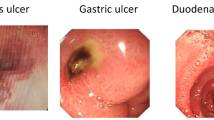Abstract
Background and Aim
The risks of peptic ulcer complications increase in association with low-dose aspirin (LDA) use. The endoscopic findings and clinical features of gastroduodenal ulcer have not been thoroughly investigated in patients taking LDA.
Method
We classified 1,041 gastroduodenal ulcer patients into three groups [patients taking LDA (group A), patients taking nonaspirin nonsteroidal anti-inflammatory drug (NSAID) (group N), and patients taking neither aspirin nor nonaspirin NSAID (group C)] and 241 bleeding gastroduodenal ulcer patients into three corresponding groups (groups a, n, and c). We investigated the clinical features, endoscopic characteristics, and endoscopic treatment of the hemorrhagic lesion in the gastroduodenal ulcer patients taking LDA and compared them with those of the other groups.
Results
The frequency of bleeding events such as hematemesis, melena, and anemia was significantly higher in group A and N than in group C. The percentage of ulcers located in the antrum was higher in group A and N than in group C, and also higher in group a and n than in group c. The percentage of ulcers located in the body, fundus, and cardia was significantly higher in the bleeding patients than in all gastroduodenal ulcer patients. The percentage of cases that required additional endoscopic treatment in group a was higher than in group c. Duration of hospitalization of group a was significantly longer than that of group c.
Conclusion
These results indicate that it is very important to prevent LDA-induced gastroduodenal ulcer complications, including bleeding.

Similar content being viewed by others
References
The SALT Collaborative Group. Swedish aspirin low-dose trial (SALT) of 75 mg aspirin as secondary prophylaxis after cerebrovascular ischemic events. Lancet. 1991;338:1345–1349.
Antiplatelet Trialists Collaboration. Collaborative overview of ramdomised trials of antiplatelet therapy-I: Prevention of death, myocardia1 infarction, and stroke by prolonged antiplatelet therapy in various categories of parents. BMJ. 1994;308:81–106.
Lauer MS. Clinical practice. Aspirin for primary prevention of coronary events. N Engl J Med. 2002;346:1468–1474.
Rl Lorenz, Schacky CV, Weber M, et al. Improved aortocoronary bypass patency by low-dose aspirin (100 mg daily). Effects on platelet aggregation and thromboxane formation. Lancet. 1984;1:1261–1264.
ISIS-2 Collaborative Group. Randomised trial of intravenous streptokinase, oral aspirin, both, or neither among 17, 187 cases of suspected acute myocardial infarction: ISIS-2. Lancet. 1988;2:349–360.
Cryer B, Feldman M. Effects of very low dose daily, long-term aspirin therapy on gastric, duodenal, and rectal prostaglandin levels and on mucosal injury in healthy humans. Gastroenterology. 1999;117:17.
Derry S, Loke YK. Risk of gastrointestinal haemorrhage with long term use of aspirin: metaanalysis. BMJ. 2000;321:1183.
Lanas A, Scheiman J. Low-dose aspirin and upper gastrointestinal damage: epidemiology, prevention and treatment. Curr Med Res Opin. 2007;23(1):163–173. Review.
Serrano P, Lanas A, Arroyo MT, et al. Risk of upper gastrointestinal bleeding in patients taking low-dose aspirin for the prevention of cardiovascular diseases. Aliment Pharmacol Ther. 2002;16:1945–1953.
Sorensen HT, Mellemkjaer L, Blot WJ, et al. Risk of upper gastrointestinal bleeding associated with use of low-dose aspirin. Am J Gastroenterol. 2000;95:2218–2224.
Nakashima S, Arai S, Mizuno Y, et al. A clinical study of Japanese patients with ulcer induced by low-dose aspirin and other non-steroidal anti-inflammatory drugs. Aliment Pharmacol Ther. 2005;21(Suppl 2):60–66.
Yeomans ND, Lanas AI, Talley NJ, et al. Prevalence and incidence of gastroduodenal ulcers during treatment with vascular protective doses of aspirin. Aliment Pharmacol Ther. 2005;22(9):795–801.
Holtmann G, Gschossmann J, Buenger L, et al. Do changes in visceral sensory function determine the development of dyspepsia during treatment with aspirin? Gastroenterology. 2002;123:1451–1458.
Niv Y, Battler A, Abuksis G, et al. Endoscopy in asymptomatic minidose aspirin consumers. Dig Dis Sci. 2005;50:78–80.
Author information
Authors and Affiliations
Corresponding author
Rights and permissions
About this article
Cite this article
Iwamoto, J., Mizokami, Y., Shimokobe, K. et al. Clinical Features of Gastroduodenal Ulcer in Japanese Patients Taking Low-Dose Aspirin. Dig Dis Sci 55, 2270–2274 (2010). https://doi.org/10.1007/s10620-009-1009-8
Received:
Accepted:
Published:
Issue Date:
DOI: https://doi.org/10.1007/s10620-009-1009-8




